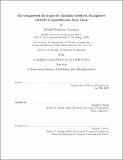Microengineered hydrogels for spatially-resolved, multiplexed microRNA quantification from tissue
Author(s)
Nagarajan, Maxwell Benjamin.
Download1193320025-MIT.pdf (18.41Mb)
Other Contributors
Massachusetts Institute of Technology. Department of Chemical Engineering.
Advisor
Patrick S. Doyle.
Terms of use
Metadata
Show full item recordAbstract
Many cancer patients develop resistance to cancer therapies over time. One major reason for resistance and disease recurrence is that cancer tissue is heterogeneous. A particular therapy may select for cells that are resistant to the therapy, leading to a more aggressive tumor over time. It is difficult to characterize the heterogeneities within cancer tissue with traditional bioassays that average over large tissue areas. Methods that can assess heterogeneities in tissue by measuring biomolecules while preserving spatial information are emerging as a key part of biological and medical studies, but there are limited technologies for quantitation and multiplexing of microRNA (miRNA), a class of small, noncoding RNAs that play important roles in many diseases. miRNA are being explored as potential therapeutic targets and as biomarkers for diagnostics. There is increasing evidence that obtaining both spatially-resolved and multiplexed measurements of miRNA is critical for diagnostic and prognostic value of miRNA tests. In this thesis, we developed a new method for making spatially-resolved and multiplexed measurements of miRNA from tissue using microengineered hydrogels. First, we used barcoded, hydrogel microparticles to perform multiplexed miRNA measurements from formalin-fixed, paraffin-embedded (FFPE) tissue, the gold standard sample type used by pathologists. In an assay that requires fewer steps and less time than existing approaches, we found the signal after an assay from FFPE tissue with paraffin was 10% less than the signal from FFPE tissue when paraffin was removed before the assay. Second, we developed and characterized a nanoliter well array platform for performing multiplexed microRNA assays from nanoliter sample volumes and applied this to microRNA measurements from unprocessed cells. By reducing sample volumes and sensing area we obtained about 100x improvement in assay sensitivity. Third, using assay conditions we found in the first project and adapting the nanoliter well arrays from the second project, we performed spatially-resolved and multiplexed measurements of microRNA directly from FFPE tissue. We achieved up to 9-plex assays and 300 [mu]m spatial resolution. We found statistically significant differences between different tumor regions from the same mouse model tissue section. We envision that this technology could be used for biomarker-based diagnostics.
Description
Thesis: Ph. D., Massachusetts Institute of Technology, Department of Chemical Engineering, May, 2019 Cataloged from the official PDF of thesis. Includes bibliographical references (pages 117-128).
Date issued
2019Department
Massachusetts Institute of Technology. Department of Chemical EngineeringPublisher
Massachusetts Institute of Technology
Keywords
Chemical Engineering.